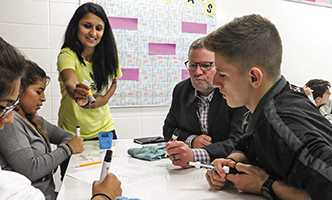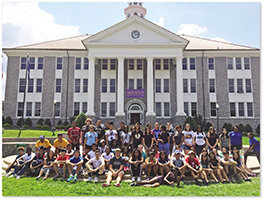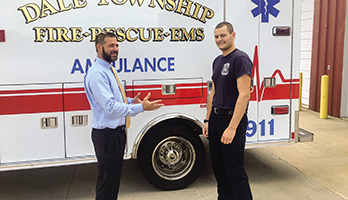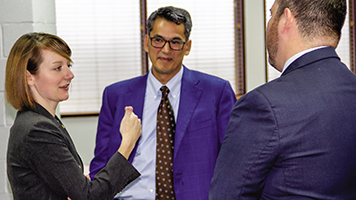November 2018: School Administrator

K-16 Convergence
This issue focuses on expanding dual enrollment options with nearby colleges and universities.
Advertisement
Additional Articles
-
 An Early Taste of College Academics
An Early Taste of College AcademicsStudents dually enrolled in high school and university classes benefit best when these four practices are part of their program
-
 Finding Expertise in Your Own Backyard
Finding Expertise in Your Own BackyardK-12 educators collaborate with a nearby university on academic offerings that serve both partners' needs and interests
-
 Motivation for the Position
Motivation for the PositionWhat factor most influenced educators to pursue their first superintendency?
-
 A Witness to Discrimination
A Witness to DiscriminationThe conflicted loyalties of a superintendent who must testify in a discrimination suit waged by a candidate for a principalship.
-
 Off-Campus Speech in the Smartphone Era
Off-Campus Speech in the Smartphone EraCan you legally discipline a student for wayward behavior online during off-school hours?
-
.png?sfvrsn=877dadd9_7) Strategies Behind a Successful Bond Referendum
Strategies Behind a Successful Bond ReferendumHow a school district’s grassroots campaign culminated in voter approval of a $27 million levy for facility improvements.
-
Embracing Firsts
DECIDING TO APPLY to become Palm Beach County, Fla.’s superintendent was not a hard decision.
-
Rigor vs. Rigor Mortis
ANOTHER WORD has entered the lexicon of overused phrases in the field of education. That word is “rigor.” It has taken its place alongside such other aphorisms as “vision,” “21st-century standards” and “data-driven instruction.”
-
.png?sfvrsn=2c854cfb_9) Breaking the Mold
Breaking the MoldCHANGES IN THE nature of work over the past several years have highlighted the importance of postsecondary education as a path to improved employability and higher earnings.
-
 Converging With Community Colleges Expands Horizons
Converging With Community Colleges Expands HorizonsCreative, cooperative arrangements ease the path for students who want to pursue college degrees with less debt.
-
Inside AASA What We Know as You Read This
Jay P. Goldman SOMETIME LAST SPRING, you may recall receiving an electronic survey that asked about the publications you receive from AASA, as well as your engagement with the association’s website and social media use.
-
Leveraging Federal Programs for Dual Enrollment
State funding and support for dual and concurrent enrollment varies across the country.
-
Concurrent Choices Serving Different Purposes
When the superintendent and high school principal in Murtaugh, Idaho, first thought about expanding course offerings in a new direction, they took advantage of several highly qualified and enthusiastic teachers
-
 Remaking Our District's Math Alignment With College Partners
Remaking Our District's Math Alignment With College PartnersRoughly three years ago, our school district in suburban Chicago began to talk seriously about postsecondary readiness and to delve into data on how our graduates were doing.
-
Three Guidelines for Sharing in a Cross-Campus Relationship
Creating a successful dual enrollment program requires willingness on the part of the partnering institutions, and the people who make up those institutions, to share resources, responsibilities and results.
-
A Set of Lesson Plans From Early College Districts
As education leaders look to expand dual enrollment for high school students, they must pay close attention to staffing strategies.
-
A Joint Project in Syracuse Leads Toward Equity
We’ll have two beers and a large pizza.” That’s the order typically placed at a campus restaurant every few months whenever Nate Franz, assistant superintendent for teaching and learning in Syracuse, N.Y.
-
 The Power of Podcasting
The Power of PodcastingA superintendent finds his periodic use of audio to be a powerful way to tell stories of his schools and students.
Staff
Editor's Note
WHEN I WAS a high schooler in Auburn, N.Y., in the
early 1970s, my school started a relationship with Syracuse University’s
Project Advance to offer a couple of university-level courses to
qualified students in the upper grades — perhaps in psychology and
English. It marked the beginning of the formal dual enrollment movement
involving secondary schools and nearby higher education institutions, at
least in my corner of the world.
Today, as this issue of School Administrator reports,
opportunities are widespread for high school students to concurrently
collect academic credits toward a college degree. Project Advance, in
its 46th year, now offers 58 university courses in about 20 disciplines
on 242 school campuses.
Our coverage will give you insights into a few of the stronger dual enrollment programs, show how some schools are managing to provide the certified instructors to teach the college-level classes and illustrate a distinctive partnership between a community college and a rural school district in central Illinois.
The convergence movement also finds universities and K-12 education
collaborating on research studies with practical implications. We
feature one such joint project in which Syracuse University is helping address student equity issues in the Syracuse City School District.
Readers are welcome to react to these articles and to inform us about
other unusual collaborations between school districts and nearby
universities.
Advertisement
Advertisement






